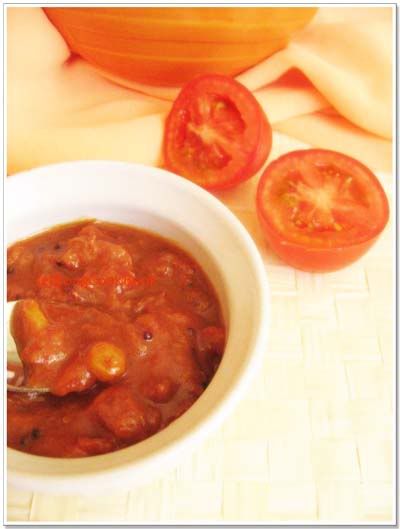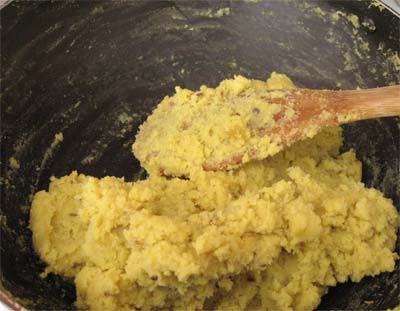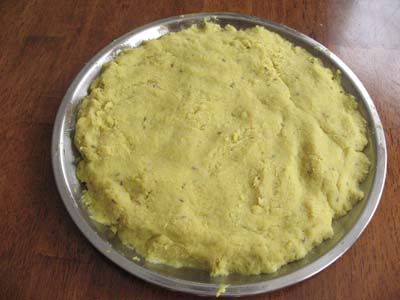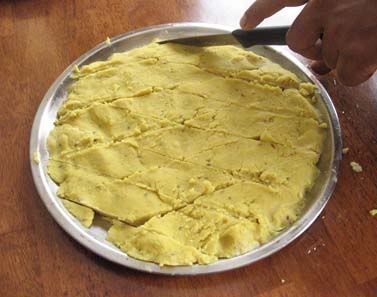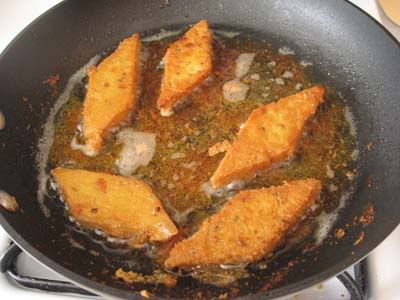Chingri Malaikari
It was a big day at 54/5,Italgacha Road. Jamai (Son in law) was visiting for the first time after Didi's(Elder sister's)wedding. Undoubtedly he was the apple of every one's eye. His face dazzled with all the attention he was getting. It was a big fat gathering.
After taking a peek into all the rooms I slipped into one of the quite corners of the house to lie down and rest my tired aching bones. They were surrounded by my Uncles, Aunts and all. Some visitors from the neighborhood had also barged in to see the new Jamai.
My Jamaibabu was not from Bengali city,so most importantly everybody was asking 'Do you get fresh fish there ?'
' What about our vegetables ?' Every question revolved around food. All these just reaffirmed that we Bengalees live and die for food !! If we know of a big meteorite heading towards earth we will spend all the time cooking and dining !
While the male members of my family kept him entertained, the female members were busy in chopping, grinding and cooking. It was a big deal and there was no stone unturned for this lavish lunch.
And when I say lavish I mean L-A-V-I-S-H!! The variety of food could easily outnumber the dishes of an restaurant. I could smell an amalgamation of Chingri Malaikari, mutton kasha, Dal,tarkari,bhaja , pulao, payesh, rasgulla and what not.
It was impossible for me to stick to ettiquetes ..... I marched straight into the kitchen, picked up my Kansa tray ..... mine because it was gifted to me and hence belonged to me. Nothing attracted me more than the Mansha (Mutton kasha) and Chingri Malaikari.
Chingri Malaikari or Prawn Malaikari , is a very famous and popular Bengali dish served with white Rice or Pulao for lunch or dinner on special occasions.It is an “Elegant Bengali Classic” – that definitely sums up this dish. It is so delicious and is a special dish so we do make it in occassion.
Main attracking ingredient is coconut milk, it is in many of the special Bengali cuisines. This particular dish is cooked in a spiced up gravy of coconut milk . Since life & it’s commodities in my childhood days was not canned or processed , my aunt and Maa had to press the grated coconut to extract the sweet white coconut milk.
Now, life is much easy and you just pick a can of coconut milk off the shelf of your grocery store. I guess this and the abundance of prawns, is also a reason why you would find Prawn Malaikari a part of the menu in most Bong parties in house.
Now, life is much easy and you just pick a can of coconut milk off the shelf of your grocery store. I guess this and the abundance of prawns, is also a reason why you would find Prawn Malaikari a part of the menu in most Bong parties in house.
N.B.
For today’s preparation get ½ lb of large prawns with heads on and ½ lb with heads removed. The reason for this being the prawns head being very very tasty adds a fourth dimension to this already delicious preparation. However if you are not very familiar around prawns, I would suggest you get only the ones with no head , as the prawn head has to be delicately cleaned.
If you want to though, go through the following steps to clean fresh prawn :-
Remove the hard shell, do not remove the tail, leave it on
De-vein the prawn, slit the back a little and take out the black thread thingy
For shrimps with heads, carefully remove only the front portion of the head the eyes etc., do not remove the entire head, you want to keep the liquidy thing inside the head.
If you want to though, go through the following steps to clean fresh prawn :-
Remove the hard shell, do not remove the tail, leave it on
De-vein the prawn, slit the back a little and take out the black thread thingy
For shrimps with heads, carefully remove only the front portion of the head the eyes etc., do not remove the entire head, you want to keep the liquidy thing inside the head.
What You Need
Prawns ~ 12 the medium size, get fresh ones, see above why I got some with heads on
Onion ~ I made a paste of a large one and used about 5 tbsp of the paste (yipe, I noted the measure)
Garlic ~ 1 large clove coarsely chopped
Ginger ~ 1 tsp
Green Chillies ~ 6 slit
Coconut Milk ~ 1 can
Onion ~ I made a paste of a large one and used about 5 tbsp of the paste (yipe, I noted the measure)
Garlic ~ 1 large clove coarsely chopped
Ginger ~ 1 tsp
Green Chillies ~ 6 slit
Coconut Milk ~ 1 can
[I bought one coconut to make milk from it and cook,but later AS USUAL I took the shortcut and used canned coocnut milk]
Mustard - 1/3 tsp
Mustard - 1/3 tsp
TejPata or Bay Leaves ~ 4 small
Elaichi or Cardamom ~ 4
Laung or Cloves ~ 6
Darchini or Cinnamon ~ 2 smallish sticks as in picture
Red Chilli Powder
Turmeric Powder
Salt
Little Sugar
How I Do It
Clean the prawns as explained earlier and mix it with turmeric and salt and keep aside for about ½ hour.
Heat oil in Kadai/Frying Pan.
Lightly fry the prawns so they turn golden in color, do not deep fry like other fish
As soon as the prawns turn a pale golden take them out .
As soon as the prawns turn a pale golden take them out .
Meanwhile grind the onion to a paste.
In the oil, add the chopped garlic.
As soon as the fragrance of the garlic rises, take out the garlic from the oil so that the oil is now garlic flavored but there is no garlic in the gravy.
Add TejPata or BayLeaves,the Elaichi, Laung & Darchini ,musturd seeds.
Add the onion paste when you see the whole garam masala crackling
Continue frying the onion with a little bit of sugar till it turns brown in color or the oil separates from the paste
Add the ginger paste and cook the masala.
Stir and add the can of coconut milk
Add a little water (about 1/3 of the can) in the can, mix well and add it too.
Add Red Chilli Powder, very little turmeric powder and salt.
Add the green chillies
Mix well and cook the gravy.
When you see the gravy slightly bubbling add the fried prawns.
Simmer for 2 minutes before turning off the heat.
N.B.
Edited On 6/2/2012
For Coconut Milk this time my steps,no shortcut~
Edited On 6/2/2012
For Coconut Milk this time my steps,no shortcut~
In a medium-size bowl, heat the water, do not boil.
Shread the coconut manually or in blender.
Place that in mixer and add 1 cup of the hot water.
Blend for 2-3 minutes.
Place a cheesecloth/very thin clean cotton cloth in a bowl.
Pour the blended coconut mixture into the cheesecloth and twist to extract the milk, letting the milk go into the bowl.
Return the coconut pulp to the blender and add the remaining 1/2 cup of hot water. Blend for 1-2 minutes, strain and press through the cheesecloth into the bowl.
In bowl,you will get coconut milk pure.
In bowl,you will get coconut milk pure.
